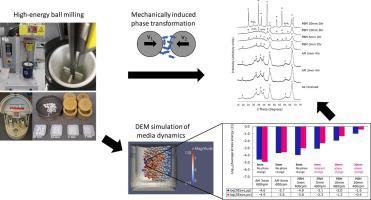当前位置:
X-MOL 学术
›
Miner. Eng.
›
论文详情
Our official English website, www.x-mol.net, welcomes your feedback! (Note: you will need to create a separate account there.)
Using Discrete Element method (DEM) simulations to reveal the differences in the γ-Al2O3 to α-Al2O3 mechanically induced phase transformation between a planetary ball mill and an attritor mill
Minerals Engineering ( IF 4.8 ) Pub Date : 2020-08-01 , DOI: 10.1016/j.mineng.2020.106374 Domenico Daraio , Jose Villoria , Andrew Ingram , Alessio Alexiadis , E. Hugh Stitt , Alexander L. Munnoch , Michele Marigo
Minerals Engineering ( IF 4.8 ) Pub Date : 2020-08-01 , DOI: 10.1016/j.mineng.2020.106374 Domenico Daraio , Jose Villoria , Andrew Ingram , Alessio Alexiadis , E. Hugh Stitt , Alexander L. Munnoch , Michele Marigo

|
Abstract In this work the γ - to α -Al2O3 phase transformation induced by mechanical milling was investigated as a function of the bead size for two laboratory scale high-energy mills: a planetary ball mill and an attritor mill. The alumina was texturally characterised, before and after milling, by Scanning Electron Microscopy (SEM) analysis, porosimetry by N2 physisorption with Brunauer-Emmett-Teller (BET) specific surface area analysis, and structurally characterised by X-Ray Diffraction (XRD), Differential Scanning Calorimetry (TGA-DSC) and Nuclear Magnetic Resonance (27Al-MAS NMR). SEM micrographs highlighted that the planetary ball mill had a better particle size reduction, while the BET surface area results indicated a greater surface area loss compared to the attritor mill. XRD patterns and 27Al MAS NMR spectra showed that depending on the intensity of the milling conditions the phase transformation was mechanically activated and most of the γ -Al2O3 was converted into α -Al2O3. The attritor mill did not supply the minimum stress energy to induce alumina crystal change; this was in contrast to the planetary ball mill which showed progressively more α -Al2O3 formation as bead size increased. For the planetary ball mill samples which did not exhibit phase transformation an exceptional fraction (15%) of pentacoordinate Al ions (AlO5) was observed, suggesting incipient transformation of the initial γ - Al2O3 structure. Consistent with the other characterisation techniques, differential scanning calorimetry (DSC) results showed that the reduction of the transformation temperature was directly proportional to the intensity of the milling conditions. The Discrete Element Method (DEM) simulations were used to model the bead motion inside the two mills and to estimate the specific energy and the stress energy for the considered experimental conditions. The simulation results coupled with the XRD patterns clearly suggested that the formation of α -Al2O3 nuclei was controlled by the stress energy. This finding could potentially be utilised as the basis scaling parameter to determine the conditions to reproduce the phase transformation in a different mill or to a different scale.
中文翻译:

使用离散元方法 (DEM) 模拟揭示 γ-Al2O3 与 α-Al2O3 机械诱导相变在行星式球磨机和超微磨碎机之间的差异
摘要 在这项工作中,研究了机械研磨引起的 γ - 到 α -Al2O3 相变与两种实验室规模高能磨机的珠粒尺寸的关系:行星式球磨机和磨碎机。在研磨之前和之后,通过扫描电子显微镜 (SEM) 分析、通过 N2 物理吸附和 Brunauer-Emmett-Teller (BET) 比表面积分析对氧化铝进行结构表征,并通过 X 射线衍射 (XRD) 进行结构表征,差示扫描量热法 (TGA-DSC) 和核磁共振 (27Al-MAS NMR)。SEM 显微照片突出显示,行星式球磨机具有更好的粒度降低,而 BET 表面积结果表明与超微粉碎机相比表面积损失更大。XRD 图案和 27Al MAS NMR 光谱表明,根据研磨条件的强度,相变被机械激活,大部分 γ -Al2O3 转化为 α -Al2O3。磨碎机没有提供引起氧化铝晶体变化的最小应力能;这与行星式球磨机形成对比,行星式球磨机随着珠粒尺寸的增加逐渐形成更多的 α-Al2O3。对于未表现出相变的行星式球磨机样品,观察到异常比例 (15%) 的五配位 Al 离子 (AlO5),表明初始 γ-Al2O3 结构发生了初期转变。与其他表征技术一致,差示扫描量热法 (DSC) 结果表明转变温度的降低与研磨条件的强度成正比。离散元方法 (DEM) 模拟用于模拟两个磨机内的珠子运动,并估计所考虑的实验条件下的比能和应力能。模拟结果与 XRD 图案相结合,清楚地表明 α-Al2O3 核的形成受应力能控制。这一发现可能被用作基础比例参数,以确定在不同轧机或不同比例下重现相变的条件。离散元方法 (DEM) 模拟用于模拟两个磨机内的珠子运动,并估计所考虑的实验条件下的比能和应力能。模拟结果与 XRD 图案相结合,清楚地表明 α-Al2O3 核的形成受应力能控制。这一发现可能被用作基础比例参数,以确定在不同轧机或不同比例下重现相变的条件。离散元方法 (DEM) 模拟用于模拟两个磨机内的珠子运动,并估计所考虑的实验条件下的比能和应力能。模拟结果与 XRD 图案相结合,清楚地表明 α-Al2O3 核的形成受应力能控制。这一发现可能被用作基础比例参数,以确定在不同轧机或不同比例下重现相变的条件。
更新日期:2020-08-01
中文翻译:

使用离散元方法 (DEM) 模拟揭示 γ-Al2O3 与 α-Al2O3 机械诱导相变在行星式球磨机和超微磨碎机之间的差异
摘要 在这项工作中,研究了机械研磨引起的 γ - 到 α -Al2O3 相变与两种实验室规模高能磨机的珠粒尺寸的关系:行星式球磨机和磨碎机。在研磨之前和之后,通过扫描电子显微镜 (SEM) 分析、通过 N2 物理吸附和 Brunauer-Emmett-Teller (BET) 比表面积分析对氧化铝进行结构表征,并通过 X 射线衍射 (XRD) 进行结构表征,差示扫描量热法 (TGA-DSC) 和核磁共振 (27Al-MAS NMR)。SEM 显微照片突出显示,行星式球磨机具有更好的粒度降低,而 BET 表面积结果表明与超微粉碎机相比表面积损失更大。XRD 图案和 27Al MAS NMR 光谱表明,根据研磨条件的强度,相变被机械激活,大部分 γ -Al2O3 转化为 α -Al2O3。磨碎机没有提供引起氧化铝晶体变化的最小应力能;这与行星式球磨机形成对比,行星式球磨机随着珠粒尺寸的增加逐渐形成更多的 α-Al2O3。对于未表现出相变的行星式球磨机样品,观察到异常比例 (15%) 的五配位 Al 离子 (AlO5),表明初始 γ-Al2O3 结构发生了初期转变。与其他表征技术一致,差示扫描量热法 (DSC) 结果表明转变温度的降低与研磨条件的强度成正比。离散元方法 (DEM) 模拟用于模拟两个磨机内的珠子运动,并估计所考虑的实验条件下的比能和应力能。模拟结果与 XRD 图案相结合,清楚地表明 α-Al2O3 核的形成受应力能控制。这一发现可能被用作基础比例参数,以确定在不同轧机或不同比例下重现相变的条件。离散元方法 (DEM) 模拟用于模拟两个磨机内的珠子运动,并估计所考虑的实验条件下的比能和应力能。模拟结果与 XRD 图案相结合,清楚地表明 α-Al2O3 核的形成受应力能控制。这一发现可能被用作基础比例参数,以确定在不同轧机或不同比例下重现相变的条件。离散元方法 (DEM) 模拟用于模拟两个磨机内的珠子运动,并估计所考虑的实验条件下的比能和应力能。模拟结果与 XRD 图案相结合,清楚地表明 α-Al2O3 核的形成受应力能控制。这一发现可能被用作基础比例参数,以确定在不同轧机或不同比例下重现相变的条件。

























 京公网安备 11010802027423号
京公网安备 11010802027423号